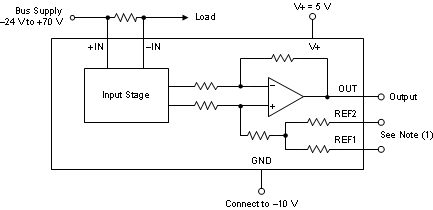ZHCS793C March 2012 – January 2021 INA282-Q1 , INA283-Q1 , INA284-Q1 , INA285-Q1 , INA286-Q1
PRODUCTION DATA
- 1 特性
- 2 应用
- 3 说明
- 4 Revision History
- 5 Pin Configuration and Functions
- 6 Specifications
- 7 Detailed Description
- 8 Application and Implementation
- 9 Power Supply Recommendations
- 10Layout
- 11Device and Documentation Support
- 12术语表
- 13Mechanical, Packaging, and Orderable Information
7.4.3 Extended Negative Common-Mode Range
Using a negative power supply can extend the common-mode range 14 V more negative than the supply used. For instance, a –10 V supply allows up to –24-V negative common-mode. Remember to keep the total voltage between the GND pin and V+ pin to less than 18 V. The positive common-mode decreases by the same amount.
The reference input simplifies this type of operation because the output quiescent bias point is always based on the reference connections. Figure 7-7 shows a circuit configuration for common-mode ranges from –24 V to 70 V.

A. Connect the REF pins as desired; however, they cannot exceed 9 V greater than the GND pin voltage.
Figure 7-7 Circuit Configuration for Common-Mode Ranges from –24 V to 70 V